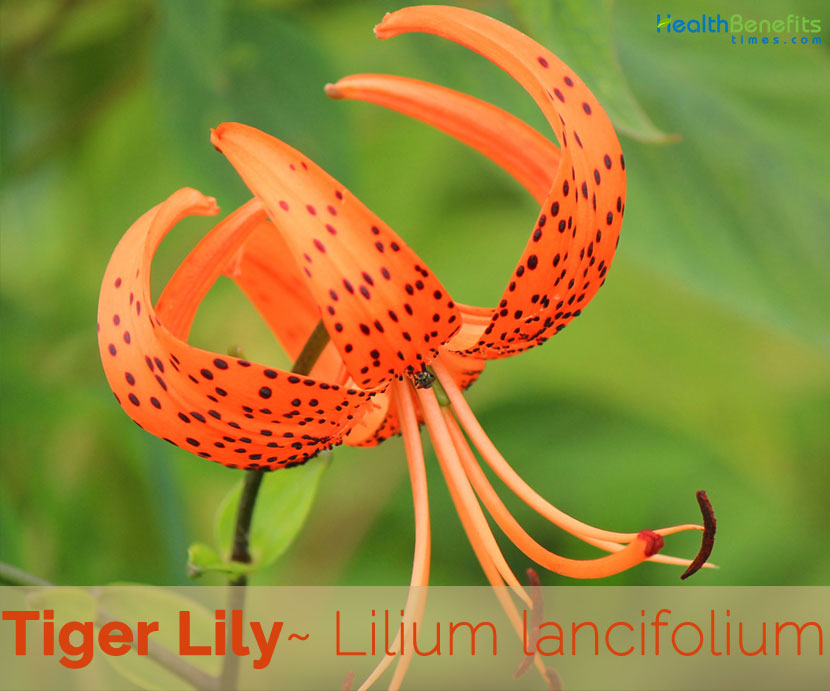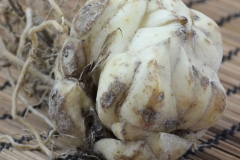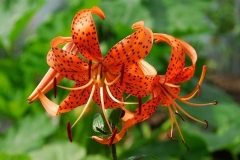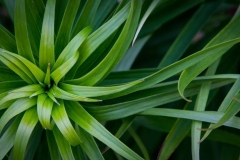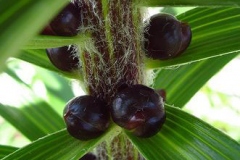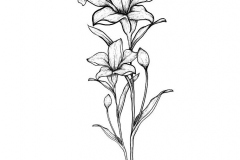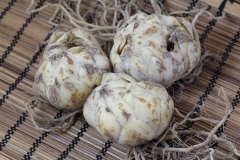| Tiger Lily Quick Facts | |
|---|---|
| Name: | Tiger Lily |
| Scientific Name: | Lilium lancifolium |
| Origin | Eastern temperate Asia mainly China, Japan and Korea |
| Shapes | 3-valved, loculicidal capsule, 3–4 cm across |
| Taste | Sweet, bitter |
| Health benefits | Beneficial for heart diseases, coughs, sore throats, palpitations, boils, bronchitis, pneumonia, tuberculosis, stress, anxiety and depression |
| Name | Tiger Lily |
|---|---|
| Scientific Name | Lilium lancifolium |
| Native | Eastern temperate Asia—China (Anhui, Gansu, Guangxi, Hebei, Henan, Hubei, Hunan, Jiangsu, Jiangxi, Jilin, Qinghai, Shaanxi, Shandong, Shanxi, Sichuan, Xizang, Zhejiang), Japan and Korea |
| Common Names | Devil Lily, Easter Lily, Garden Lily, Japanese Show Lily, Kentan, Lance-Leaf Tiger Lily, Martagon, Tiger Lily, Leopard Lily, Pine Lily, Lilium catesbaei, Columbia lily, Oregon Lily, Western Wood Lily, Chalice-Cup Lily, Western Red Lily |
| Name in Other Languages | Brazil : Lírio-De-Tigre Bulgarian: Tigrov krem (тигров крем), tigrova liliya (тигрова лилия) Chinese : Juan-Dan, Chuan-Tan, Bai-He, Pai-Ho, Suan-Nao-Shu Czech : Lilie Tygrovaná Danish : Tiger-Lilje Dutch : Tijgerlelie English: Easter Lily, Devil lily, Kentan, martagon, Tiger lily, Lance-leaved tiger lily Finnish : Tiikerililja French : Lis Elegant, Lis tigré German : Tiger-Lilie Hungarian: Tigrisliliom India : Liliyama Lancifolium Italian : Giglio Cinese, Giglio Tigrino Japanese : Oni-Yuri (オニユリ) Korean : Chamnari Malayalam: Taigar lilli (ടൈഗർ ലില്ലി) Norwegian : Tigerlilje Persian: لیلیوم لانکیفلیوم Polish : Lilia Tygrysia Portuguese : Laço De Ouro, Laço De Prata, Lírio Tigrino, lírio-de-tigre Russian : Lilija Tigrinaja, Liliya lantsetolistnaya (Лилия ланцетолистная) Slovak: Lalia tigrovaná Spanish : Lirio De Tigre Swedish : Sen Tigerlilja, Tigerlilja, Tiikerilija Turkish : Kaplan Zambağı, Türk Zambağı, Zambak Vietnamese : Hoa Lo Kèn Vằn, Loa Kèn Vằn, Quyển Ðơn |
| Plant Growth Habit | Hardy, vigorous, bulbous herbaceous, perennial plant |
| Growing Climates | Woods, thickets, river banks, grassy slopes in lowlands, hillsides and mountains, buildings, cemetery prairies, savannas, abandoned homestead sites, vacant lots in urban areas, roadsides, and areas along railroads |
| Soil | Grows well in full sun, in well-drained, humus-rich loamy soil |
| Plant Size | About 1 to 1.5 meters tall and can reach a width of 30 to 60 centimeters |
| Bulb | Ovate to spherical, 4–8 cm across, scales broadly ovate, 2 cm long and wide, unsegmented |
| Stem | 0.8–1.5 m, erect, unbranched, light green, purplish green, or purple, terete, and moderately woolly-hairy to glabrous |
| Leaf | Alternate, cauline, linear lanceolate, 3–8 cm long. 1.5–2 cm wide, distal leaves bearing purplish black bulbils at axils |
| Flowering season | August to September |
| Flower | Showy, 3–6(−20) in a nodding raceme, to 12 cm across, subtended by leafy bracts, orange-red spotted purple black, perianth segments 6 funnel form, strongly reflexed, each with a vasal nectar-bearing gland; stamens 6, anthers versatile |
| Fruit Shape & Size | 3-valved, loculicidal capsule, 3–4 cm across, the margins of valves flat; seeds many, flat, in 2 rows in each cell |
| Propagation | By division, by planting stem bulblets, or planting the bulbils |
| Flavor/Aroma | Strong, sweet and distinctively lily smell |
| Taste | Sweet, bitter |
| Plant Parts Used | Bulb, flower |
| Season | September to October |
| Precautions |
|
Plant Description
Tiger Lily is a hardy, vigorous, bulbous herbaceous, perennial plant that normally grows about 1 to 1.5 meters tall and can reach a width of 30 to 60 centimeters. The plant is found growing in woods, thickets, river banks, grassy slopes in lowlands, hillsides and mountains, buildings, cemetery prairies, savannas, abandoned homestead sites, vacant lots in urban areas, roadsides and areas along railroads. The plant grows well in full sun, in well-drained, humus-rich loamy soil. It is widely cultivated in Asia for its edible bulbs and for medicinal uses. Stems are 0.8–1.5 m, erect, unbranched, light green, purplish green, or purple, terete, and moderately woolly-hairy to glabrous.
Bulbs
Bulbs are ovate to spherical, 4–8 cm across, scales broadly ovate, 2 cm long and wide and are unsegmented. Bulb is occasionally used as a vegetable, like a parsnip. It must be boiled as it can be quite toxic. Its bitterish taste is a lovely companion to stews and other thick dishes. It was grown as a root crop for many years on farms in Asia. The bulb is anti-inflammatory and used as a diuretic in some instances. They are used in Korea to treat coughs, sore throats, and heart palpitations.
Leaves
The alternate leaves along the stem are densely distributed in pseudo-whorls and widely spreading. The lower leaves are 4-6 inches long and ½-¾ inches across. They are medium green, linear-lanceolate, smooth along their margins, glabrous, and sessile. The tips of the lower leaves are acute. The upper leaves are 1½-3 inches long and ½-¾ inches across. They are medium green, narrowly lanceolate to lanceolate, smooth along their margins, and glabrous, clasping the stem at their bases. The tips of the upper leaves are blunt. Leaf venation is parallel. At the bases of upper leaves, there are 1-3 aerial bulblets that are black to dark purple, ovoid in shape, up to ½ inches long, and sessile. Each bulblet consists of a single scale or 2-3 partially merged scales.
Flowers
Each flower consists of 6 strongly recurved tepals that are orange to orange-red, 6 strongly exerted stamens, a strongly exerted style with a tripartite stigma, and an ovary. Tepals are narrowly lanceolate and they have dark purple or maroon spots throughout their anterior (frontal) sides. The tips of the tepals bend backward toward the base of the corolla or a little behind the corolla. The style and filaments of the stamens are whitish orange and filiform. Anthers are long, narrow, and dark-colored; their pollen is rust-colored. Blooming period occurs during mid- to late summer, lasting about 1-1½ months. Individual flowers are short-lived, but they are produced in succession. There is little or no floral scent. Because most cultivated and naturalized plants in North America are sterile triploids, usually no seed capsules are produced. Fertile flowers are followed by 3-valved, loculicidal capsule, 3–4 cm across, the margins of valves flat; seeds many, flat, in 2 rows in each cell.
Tincture is commonly made from the flower, harvested only in full bloom, and is used to treat congestion and sometimes to help with nausea. Some believe the flower can be used to treat heart disease. In ancient Asia, it was thought to help deal with issues of aggressivity. Somewhat paradoxically, the tiger lily is very toxic to cats, leading to symptoms of lethargy, vomiting, possible kidney failure, and even death. There is no known toxicity to other species.
History
Tiger lily is native to eastern temperate Asia mostly China (Anhui, Gansu, Guangxi, Hebei, Henan, Hubei, Hunan, Jiangsu, Jiangxi, Jilin, Qinghai, Shaanxi, Shandong, Shanxi, Sichuan, Xizang, Zhejiang), Japan and Korea. The species has also naturalized in other temperate regions of the world (e.g. northern and eastern USA, Canada and New Zealand). It has been introduced and grown as ornamental in subtropical and temperate areas elsewhere.
This species is also a widespread but sporadic garden escape in eastern and north-eastern North America, and seems to be naturalized mainly along roadsides in the cooler and wetter regions of this continent. However, there is one very recent report of thousands of tiger lilies growing in large patches in natural vegetation on a mountain-top in North Carolina. It is also a weed of roadsides, waste places, cemeteries and bush margins in New Zealand.
Traditional uses and benefits of Tiger Lily
- Bulb is anti-inflammatory, diuretic, emmenogogue, emollient and expectorant.
- They are used to relieve heart diseases, pain in the cardiac region and angina pectoris and prescribed for the treatment of myopic astigmatism and to strengthen the eyelid muscles.
- They are used in traditional medicine to treat coughs, sore throats, palpitations and boils and also commonly used to treat bronchitis, pneumonia, etc. in Korea
- It has a sedative influence and is used for cough and tuberculosis.
- The flowers are carminative.
- Tincture made from the flowering plant, harvested when in full flower, is used in the therapy of uterine neuralgia, congestion, irritation and the nausea of pregnancy.
- It relieves the bearing-down pain accompanying uterine prolapse and is an important remedy in ovarian neuralgia.
- Flowers are used to strengthen the eye-lid muscles and are much-admired in the treatment of myopic astigmatism.
- Tiger Lily flower essence helps in suppressing aggressive tendencies in individuals and helps in holistic healing.
- Tincture also helps reduce vaginal and pelvic inflammation, and relieve pain from menstrual, fibroids, or menopausal symptoms.
- Tiger Lilies help in relieving stress, anxiety, and depression.
- Tiger Lily soup or tea works best, while perfumes or sachets can be used to calm or suppress anxiety.
Culinary Uses
- Tiger lily bulbs and flowers (with stamens removed) are edible.
- Flower is used either fresh or cooked in salads, soup rice dishes or dried and used as spice for seasoning.
- Flowers add a delicate flavor to salad and other dishes.
- Fleshy scales of the bulb are eaten fresh or cooked in Chinese cooking.
- They are traditionally eaten in the summer season and are deemed to have a cooling effect.
- The starch-rich bulbs may also be baked, grated or ground into flour.
- The bulb is also pickled.
- Bulb when properly cooked are highly valued as a vegetable and somewhat resemble parsnips in flavor.
- Bulb can be dried and ground into powder.
- Flowers can be consumed raw or cooked.
- Flowers can be used fresh or dried in salads, soups, rice dishes etc.
Other Facts
- Tiger lily is cultivated as a popular ornamental plant and as a medicinal plant.
- Tiger Lily was first described by the famous Swedish botanist Carl von Linne (Linnaeus) in 1753.
- Tiger Lily has some toxic effects on cats. It can produce vomiting, in appetence, lethargy, kidney failure, and even death.
- Tiger lily is sometimes called the “Ditch Lily,” as it is commonly found growing in the wild, in ditches.
- In the language of flowers, tiger lilies represent wealth and prosperity.
- There is a misconception that smelling tiger lilies will give you freckles.
References:
https://www.itis.gov/servlet/SingleRpt/SingleRpt?search_topic=TSN&search_value=503455#null
https://pfaf.org/user/plant.aspx?LatinName=Lilium+lancifolium
https://plants.usda.gov/core/profile?symbol=LILA8
http://floraofalabama.org/Plant.aspx?id=4481&display=photos
https://en.wikipedia.org/wiki/Lilium_lancifolium
http://mgb.cimmyt.org/gringlobal/taxonomydetail.aspx?id=104679
https://www.wikidata.org/wiki/Q266317
https://npgsweb.ars-grin.gov/gringlobal/taxonomydetail.aspx?id=104679
https://en.hortipedia.com/index.php?title=Lilium_lancifolium&mobileaction=toggle_view_mobile
https://gd.eppo.int/taxon/LILLA
http://www.theplantlist.org/tpl1.1/record/kew-279922?ref=tpl1
https://www.minnesotawildflowers.info/flower/tiger-lily


